The Qualcomm Snapdragon 820 Performance Preview: Meet Kryo
by Ryan Smith & Andrei Frumusanu on December 10, 2015 11:00 AM EST- Posted in
- SoCs
- Snapdragon
- Qualcomm
- Snapdragon 820
GPU Performance
Shifting gears, let’s take a look at GPU performance. As we mentioned earlier, Qualcomm isn’t disclosing much about this GPU other than that it packs quite a bit more computational power than its predecessor and should be quite a bit faster in the process. This points to a potentially significant architectural shift, but that determination will have to wait for another time.
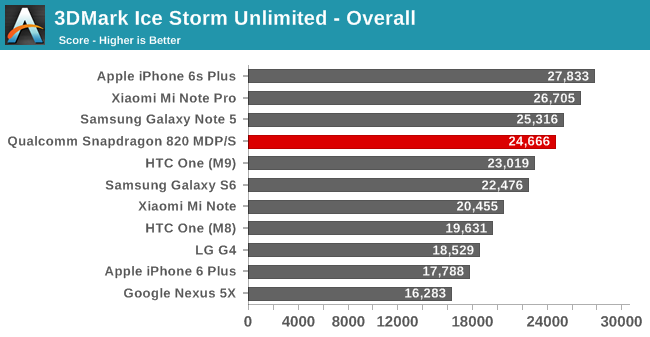
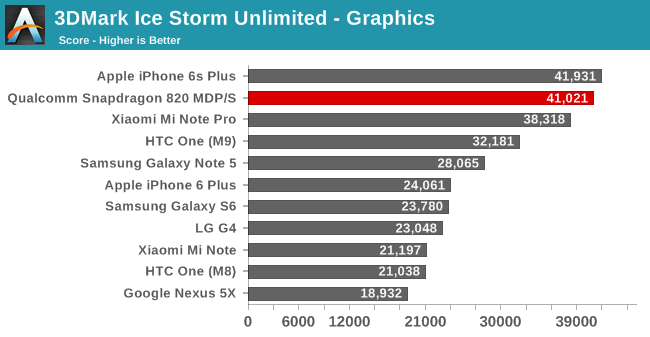
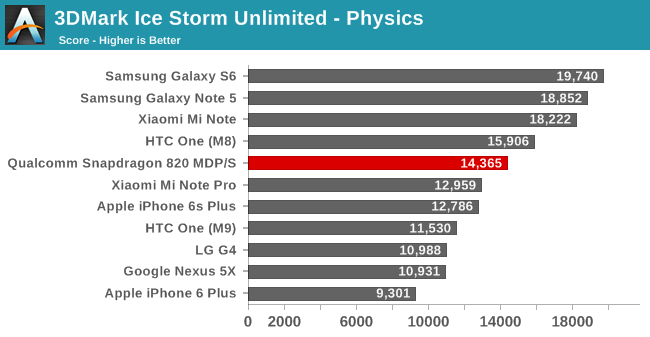
Starting with 3DMark Ice Storm Unlimited, the performance honestly doesn’t start out great. The overall score is significantly influenced by the physics score, which in turn is more concerned with the number of cores and their throughput on simple code than the ability to extract complex IPC. As a result the 4 CPU core 820 simply can’t catch up with the likes of the Samsung devices and their high-clocked big.LITTLE configurations. On the other hand the graphics score makes this the fastest Android phone to date, though relative to the 810 Mi Note Pro, perhaps not by a ton. Ultimately as this is an OpenGL ES 2.x test it’s not the most strenuous of tests these days, and comments from Qualcomm indicate that it may be a CPU-limited test on 820.
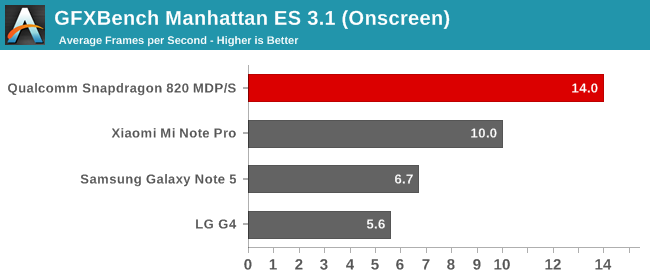
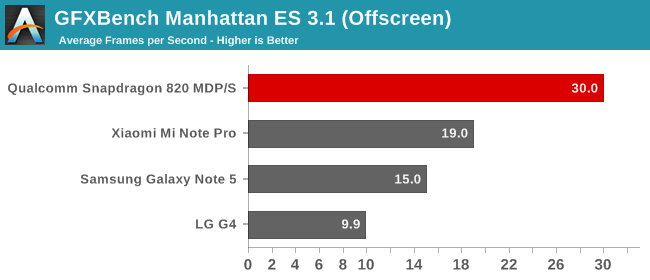
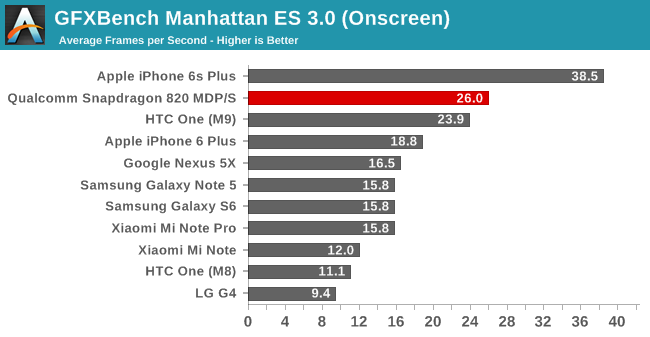
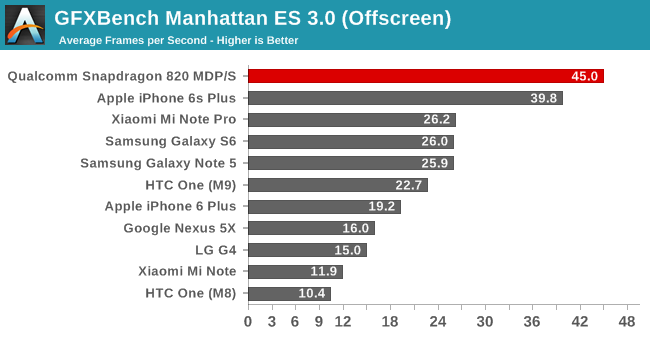
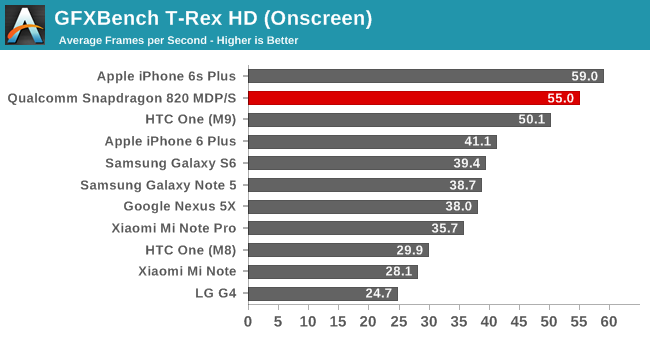
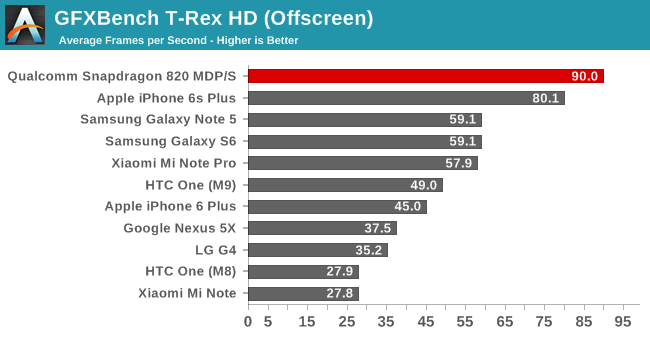
GFXBench on the other hand shows some massive gains for the 820 relative to any other Android device. In offscreen rendering mode, all 3 game tests – Manhattan ES 3.1, Manhattan ES 3.0, and T-Rex HD – put the 820 MDP/S as being 52% (or more) faster than the next-fastest Android device, either the 810 based Mi Note Pro or the Exynos 7420 based Samsung Galaxy Note 5. The single biggest jump we see is with Manhattan ES 3.0 at 72%, while the ES 3.1 version dials that back down to 52%. Even the iPhone 6s Plus, well known for its powerful GPU, is handily and consistently surpassed by the 820 here. Only due to the 6s Plus’s lower rendering resolution of 2208x1242 does it surpass the MDP/S in onscreen tests, as the latter needs to render at 2560x1600 (~50% more pixels). Qualcomm was aiming for some big GPU performance gains here and so far they are delivering.

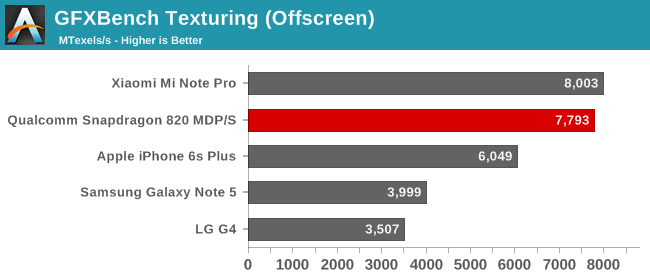
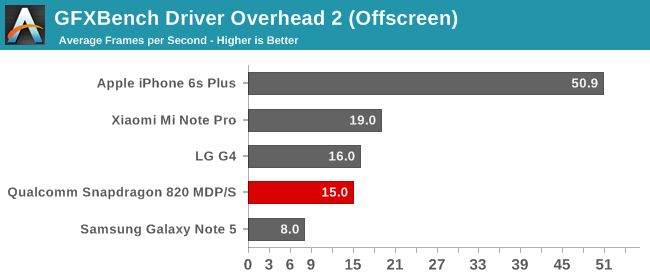
Curiously, GFXBench’s synthetic feature tests don’t show the same gains. Offscreen ALU performance is only slightly improved over the 810 (10%) or in the case of texturing is an outright regression. None-the-less full gaming performance is clearly in the 820’s favor. I’ve long suspected that the Adreno 430 GPU in the 810 had some kind of architectural bottleneck – perhaps an ALU/texture array that was difficult to fully utilize – and what we’re seeing here would back up that claim, as if that was the case then correcting it would have allowed Qualcomm to significantly boost their rendering performance while only barely changing their synthetic performance. Otherwise I find it a bit surprising that the driver overhead score is a bit worse on 820 than 810, which may be a result of the immature GPU drivers on this early device.










146 Comments
View All Comments
V900 - Friday, December 11, 2015 - link
In quite a few examples also coming in behind the A8, which is two years older than this SOC will be when it hits the street, don't forget about that!In all fairness, Qualcomm's development devices, like the mdp820, are rarely tuned for performance, and many of the drivers may still have some rough edges around them.
But they're also nowhere near as demanding in terms of battery size and thickness as the production models that vendors will release sometime next year.
The MDP820 is 11 mm thick, and has a battery with over 3000mah, which means that It's hard NOT to provide ample cooling and plenty of battery life.
That may prove to be a lot harder in a cellphone with a sub 9mm case and a 2500 mah battery.
And let's not forget, that when Anandtech tested the 810MDP, there wasn't a trace of overheating to be found.
http://slatedroid.info/2015/02/anandtech’s-snapdragon-810-preview-no-overheating-issues-spotted/
StrangerGuy - Thursday, December 10, 2015 - link
If you ask me Qualcomm's main problem is not the chip but rather Android software is overwhelming built to run on lowest common denominator hardware.tuxRoller - Friday, December 11, 2015 - link
You do realize that what you're saying is that android has been built to be svelte? This is actually somewhat true given their android one initiative. In practice it would mean that far from being bloated (a really common criticism that folks like to throw at...pretty much any software they are having issues with), it is very carefully built to be used with low hardware requirements. IOW, it would be extraordinarily fast on high-end hardware.All of this is to say that you're mostly wrong.
V900 - Friday, December 11, 2015 - link
Ehm, no. Actually it would be you who is wrong.Being built to run on lowest common denominator hardware isn't necessarily the same as doing it well.
Just look at how fast and smooth WP 7/8/8.1 or iOS runs on phones with just 512 or even 256mb RAM, and compare it with the asthmatic performance you'd usually see from an Android handset with twice as much RAM.
Android has always been bloated and slow compared to its competition (aside from Symbian and BBOS), and part of the explanation is probably that it's developed with the lowest common denominator in mind, with the focus placed on delivering acceptable performance on a handful of SOCs instead of delivering outstanding performance on one or two SOCs.
tuxRoller - Friday, December 11, 2015 - link
You haven't explained why I'm wrong except to say I'm wrong.Aiming for acceptable performance in low end devices implies much better performance on much better hardware (all else being equal
.. which is the case here).
Also, keep in mind that i didn't agree with the premise that Android is built with the lcd in mind.
UtilityMax - Saturday, December 12, 2015 - link
iOS runs like crap on those devices with 256-521MB of RAM. I used used my iPhone 4 recently.UtilityMax - Saturday, December 12, 2015 - link
Your argument makes sense whatsoever. If Android is designed for low end "least common demonstrator" hardware, then it should run circles around the high end hardware?Anyways, I have heard your argument before, and I heard it many times when the apple fan boys explain why Apple gives you so little memory in its flagship phones. Well guess what, Android doesn't need much memory either. You can do just fine with 1 or 2GB of memory. But in this time, memory is getting dirty cheap so Android phone vendors often throw in a bit of memory as a bonus. On the other hand, Apple has always been an expert at charging the most money for the least hardware. Hence, the "apology" from apple and the apply fan boys that apple gives you so little memory because Apple can run just fine with only 1GB but android cannot. This argument is utterly and stupidly wrong.
Mondozai - Saturday, December 12, 2015 - link
Calling people fanboys on mobile tech discussions is our equivalent of Godwin's law. You are just showing the limits of your intellect.Fact is, Android is more bloated because it has far more targets to hit than iOS. But it's still miles ahead of where it used to be.
Constructor - Saturday, December 12, 2015 - link
Actually, Android devices need a lot more RAM to keep the permanent stuttering from garbage collection halfway under control (but still can't eliminate it because it is fundamentally inherent).iOS apps only need to push out other unusued apps initially (which can be noticeable but which is required on Android as well) but after they've gained enough RAM they can run completely stutter-free indefinitely since iOS uses deterministic memory management without garbage collection.
As a consequence iOS devices can deliver completely smooth gaming performance, for instance, even with a lot less RAM and without the associated battery power draw, something which Android is fundamentally incapable of due to the choice of garbage collection.
TheinsanegamerN - Sunday, December 13, 2015 - link
I have a lumia 635 with 512MB of ram. runs like @$$. Slow, laggy, slow loading times, crashing programs. Moto g with 1GB runs flawlessly by comparison.